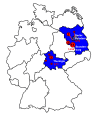Detection of hepatitis E virus in wild boars of rural and urban regions in Germany and whole genome characterization of an endemic strain
- PMID: 19442307
- PMCID: PMC2689194
- DOI: 10.1186/1743-422X-6-58
Detection of hepatitis E virus in wild boars of rural and urban regions in Germany and whole genome characterization of an endemic strain
Abstract
Background: Hepatitis E is an increasingly diagnosed human disease in Central Europe. Besides domestic pigs, in which hepatitis E virus (HEV) infection is highly prevalent, wild boars have been identified as a possible source of human infection. In order to assess the distribution of HEV in the wild boar population of Germany, we tested liver samples originating from different geographical regions for the presence of the HEV genome and compared the detected sequences to animal and human HEV strains.
Results: A total of 148 wild boar liver samples were tested using real-time RT-PCR resulting in an average HEV detection rate of 14.9% (95% CI 9.6-21.6). HEV was detected in all age classes and all geographical regions. However, the prevalence of HEV infection was significantly higher in rural as compared to urban regions (p < 0.001). Sequencing of the PCR products indicated a high degree of heterogenicity of the detected viruses within genotype 3 and a grouping according to their geographical origin. The whole genome sequence of an HEV isolate (wbGER27) detected in many wild boars in the federal state of Brandenburg was determined. It belongs to genotype 3i and shows 97.9% nucleotide sequence identity to a partial sequence derived from a human hepatitis E patient from Germany.
Conclusion: The results indicate that wild boars have to be considered as a reservoir for HEV in Germany and that a risk of HEV transmission to humans is present in rural as well as urban regions.
Figures




Similar articles
-
Hepatitis E and Potential Public Health Implications from a One-Health Perspective: Special Focus on the European Wild Boar (Sus scrofa).Pathogens. 2024 Sep 27;13(10):840. doi: 10.3390/pathogens13100840. Pathogens. 2024. PMID: 39452712 Free PMC article. Review.
-
Detection and genetic characterization of hepatitis E virus (HEV) genotype 3 subtype c in wild boars in Italy.Arch Virol. 2016 Oct;161(10):2829-34. doi: 10.1007/s00705-016-2964-y. Epub 2016 Jul 8. Arch Virol. 2016. PMID: 27393602
-
Prevalence and phylogenetic analysis of hepatitis E virus in pigs, wild boars, roe deer, red deer and moose in Lithuania.Acta Vet Scand. 2018 Feb 23;60(1):13. doi: 10.1186/s13028-018-0367-7. Acta Vet Scand. 2018. PMID: 29471843 Free PMC article.
-
Molecular characterization of a novel hepatitis E virus (HEV) strain obtained from a wild boar in Japan that is highly divergent from the previously recognized HEV strains.Virus Res. 2014 Feb 13;180:59-69. doi: 10.1016/j.virusres.2013.12.014. Epub 2013 Dec 24. Virus Res. 2014. PMID: 24370869
-
Epidemiology of hepatitis E in South-East Europe in the "One Health" concept.World J Gastroenterol. 2019 Jul 7;25(25):3168-3182. doi: 10.3748/wjg.v25.i25.3168. World J Gastroenterol. 2019. PMID: 31333309 Free PMC article. Review.
Cited by
-
Novel hepatitis E virus genotype in Norway rats, Germany.Emerg Infect Dis. 2011 Oct;17(10):1981-3. doi: 10.3201/eid1710.101399. Emerg Infect Dis. 2011. PMID: 22000397 Free PMC article. No abstract available.
-
Hepatitis E and Potential Public Health Implications from a One-Health Perspective: Special Focus on the European Wild Boar (Sus scrofa).Pathogens. 2024 Sep 27;13(10):840. doi: 10.3390/pathogens13100840. Pathogens. 2024. PMID: 39452712 Free PMC article. Review.
-
Seroprevalence and Incidence of hepatitis E in blood donors in Upper Austria.PLoS One. 2015 Mar 9;10(3):e0119576. doi: 10.1371/journal.pone.0119576. eCollection 2015. PLoS One. 2015. PMID: 25751574 Free PMC article.
-
A broadly cross-reactive monoclonal antibody against hepatitis E virus capsid antigen.Appl Microbiol Biotechnol. 2021 Jun;105(12):4957-4973. doi: 10.1007/s00253-021-11342-7. Epub 2021 Jun 15. Appl Microbiol Biotechnol. 2021. PMID: 34129082 Free PMC article.
-
Natural and experimental hepatitis E virus genotype 3-infection in European wild boar is transmissible to domestic pigs.Vet Res. 2014 Nov 26;45(1):121. doi: 10.1186/s13567-014-0121-8. Vet Res. 2014. PMID: 25421429 Free PMC article.
References
-
- Herremans M, Vennema H, Bakker B, Veer B van der, Duizer E, Benne CA, Waar K, Hendriks B, Schneeberger P, Blaauw G, Kooiman M, Koopmans MPG. Swine-like hepatitis E viruses are a cause of unexplained hepatitis in the Netherlands. J Viral Hep. 2007;14:140–146. doi: 10.1111/j.1365-2893.2006.00786.x. - DOI - PubMed
Publication types
MeSH terms
Substances
Associated data
- Actions
- Actions
- Actions
- Actions
- Actions
- Actions
- Actions
- Actions
- Actions
- Actions
- Actions
- Actions
- Actions
- Actions
- Actions
- Actions
- Actions
- Actions
LinkOut - more resources
Full Text Sources
Other Literature Sources

